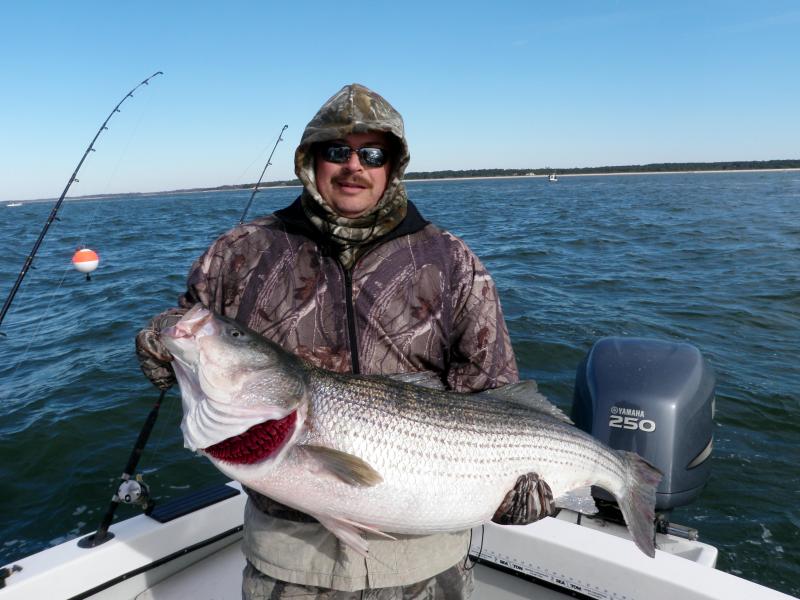More on the satellite-tagged striped bass
A few weeks ago, we told you about a MiniPSAT tag that was found by Lewes residents along the beach. The tag had been placed in a 46-inch striped bass July 3 off Montauk, N.Y., by a crew from the Fisherman Magazine onboard the charter boat Tyman with Capt. Chuck Many. This fish, named Independence for the holiday, was the third striper tagged and released by the Northeast Striped Bass Study in 2020. The other two, named Cora and Rona, were tagged and released around Memorial Day about two-and-a-half miles off Sandy Hook, N.J.
Fortunately, all three tags popped off the fish and were recovered by folks walking the beach. Since the tags were recovered, new ones will not have to be purchased at $5,000 a pop for the 2021 study.
As soon as they came off the fish, they began transmitting to an Argos satellite, allowing the folks at Gray Fish Tag Research to plot the travels of the fish during the past four months. Cora and Rona stayed outside the Three-Mile Limit, with Rona going deep into the Hudson Canyon before heading back to Long Island. Cora also spent time close to the canyons, and both fish were on Nantucket Shoals.
Independence headed in a southeasterly direction, cruising in 100 to 180 feet of water before moving back north toward Nantucket Shoals. After leaving Nantucket Shoals, Independence made a straight line southwest into Delaware Bay, where the MiniPSAT tag popped off near Fortescue, N.J. The tag then floated around Delaware Bay before ending up on Lewes Beach.
The only thing all three fish have in common is the Nantucket Shoals. These are very good feeding grounds with a constantly shifting sand bottom that holds bait such as sand eels. It has also become a go-to spot for trophy summer flounder. The big stripers spend almost the entire summer beyond the Three-Mile Limit.
All of this information was printed in the February edition of the Fisherman Magazine. The article is written by Jim Hutchinson Jr., who has been on the forefront of this research project.
As with all research projects in the early stages, this one creates more questions than it answers. Take Independence, for example. Being caught off Montauk, you would think it was a Long Island Sound or Hudson River fish. Yet it returned to Delaware Bay. Did it travel the coast up to Montauk after breeding in Delaware Bay? Do stripers always go back to the same breeding grounds every year? We thought we knew so much about striped bass, and it turns out we know so little.
Bad weather, bad fishing
Fishing in the Cape Region has been generally bad for quite a while. The problem is the series of storms that have followed one another in a seemingly never-ending chain from the West Coast. Believe it or not, there has been some good news in that the storms have come from the west, keeping the air temperature at or above freezing, so we have been spared much of the snow that has covered areas to our south and west. The water temperature in the ocean has remained at or above 40 degrees, so once the wind goes east, the precipitation turns to rain.
With air temperatures above freezing, the freshwater ponds have remained ice-free, so a few dedicated anglers have been able to catch some bass, crappie and pickerel out of ponds, spillways and the upper reaches of tidal rivers and creeks. Live bait such as minnows, worms and grass shrimp have been the top producers. Fished on a crappie jig either alone or under a bobber is the most popular presentation. A Mepps spinner is a good lure.
Delaware’s trout season should begin in Kent and Sussex counties Saturday, March 6, but when I contacted the Fish and Wildlife Section of DNREC, I was told they were still working out the details of how to open the season while maintaining COVID-19 safety. The final rules should be available next week, and I will pass them along as soon as they are posted.
Virginia has opted to have a black sea bass season during February, and from the reports I have received, the boats that have been getting out are doing well. They must report leaving and returning on all trips as well as what they catch. All days fished during February must be made up during the regular season from May 15 to Dec. 31.
All East Coast states had this option, but only Virginia took advantage of the offer. They are the farthest south and have the best chance of good-weather days. Virginia also has an active tog fishery during the winter.

























































